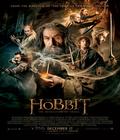It's been one year since "The Hobbit: An Unexpected Journey" debuted in theaters. The first installment of the story boasted impressive visuals, but it lacked the dramatic heft of a full film because it was only the first portion of the book. Rather than present a complete story, it simply stopped mid-tale. "The Desolation of Smaug" covers the central part of "The Hobbit," so it moves the story along quite a bit more, but like "An Unexpected Journey," it also ends abruptly.
After starting with a flashback, "The Desolation of Smaug" jumps into the action. Bilbo (Martin Freeman), Gandalf (Ian McKellen) and the dwarves are still being pursued by the Orcs, who were attempting to kill them at the end of the last film. Taking refuge with a shape shifter, the group rests for the night before making its way to Mirkwood Forest.
Though the actual narrative during the chase sequence is light, the film doesn't hesitate to show off the natural beauty of New Zealand, which once again serves as an impressive Middle-earth. Simply watching the group move across varying terrain is a testament to the eye of those behind the camera, as each shot is framed like a moving painting.
Once inside Mirkwood, the general feeling changes due to the more compressed camera shots. Rather than showing off a wide landscape, the cameras get in close to help convey a subtle sense of claustrophobia to the viewer. It's a nice way of foreshadowing a battle with the giant spiders of Mirkwood, which is where Bilbo's sword officially gets named.
Unfortunately, the one major element lost in the action is the danger posed by the spiders. After Bilbo takes out the first one with Sting, the fighting starts in earnest, and the group of dwarves never seems to be at any real disadvantage. In fact, they appear to be winning almost immediately after going on the offensive. It's as though the spiders were never more than a nuisance, as the dwarves are only subdued by an Elven hunting party.
Leading the group of Elves are Legolas (Orlando Bloom) and Tauriel (Evangeline Lilly). Legolas is younger version of the character seen in "The Lord of the Rings" trilogy, and Bloom plays him that way. This younger Legolas is aggressive and athletic while fighting, but he also seems to look down on other races. Even though the dwarves were being attacked by the spiders, Legolas still treats them as invaders in the land.
Tauriel is a new character, created exclusively for the films, but if you had never read the book, you wouldn't know it. Lilly seems to have thrown herself wholeheartedly in to the role, portraying Tauriel as a young, impulsive Elf, but also one who hasn't lost the ability to see joy in the world. She never seems out of place, providing a good balance to Legolas' character, offering different viewpoints and an equal level of skill on the battlefield. Tauriel could easily be mistaken for one of J.R.R. Tolkien's original characters.
Ultimately, the group makes its way to Lonely Mountain for the climactic battle with Smaug (Benedict Cumberbatch), who doesn't disappoint. On a visual level, Smaug is an impressive piece of CGI work, moving and looking as though he were real. The digital character has a real sense of heft about him, while the lighting details appear to get even minute shadows right. This is a CGI character that doesn't look like a CGI character.
As far as performance, Cumberbatch absolutely nails Smaug's smug attitude. Yes, the words were Tolkien's, but the delivery is what matters here, and Cumberbatch's voice work is exactly what we expected Smaug to sound like when first reading "The Hobbit" many years ago.
If the battle with Smaug is the film's high point, it also serves double duty at the low point, not because of anything that happens, but rather because of what doesn't happen. Rather than breaking the film at a natural lull in the action as the first installment did, "The Desolation of Smaug" simply cuts to black halfway through the climactic battle with the dragon. It was an extremely cheap way to attempt a cliffhanger (especially given that many fans already know the story) and is sure to annoy quite a few filmgoers. After investing two and a half hours, the viewer is left feeling a bit cheated by the sudden end.
Though it's a better experience than "An Unexpected Journey," "The Desolation of Smaug" reinforces the idea that splitting a single story into three films wasn't the best of choices. Sure, it means more profit for Warner Brothers, but the story and the experience suffers for it. With that said, if you're even a mild Tolkien fan, seeing Smaug rendered on the big screen in all his glory is worth it, warts and all.
Score: 6.5/10
"The Hobbit: The Desolation of Smaug" is rated PG-13 and has a running time of 2 hours and 41 minutes. It is showing in 2-D, 3-D, IMAX 3-D and HFR 3-D.
More articles about The Hobbit: The Desolation of Smaug











 The Desolation of Smaug continues the adventure as the group travels east, encounters a skin-changer, giant spiders, and Wood-elves. Then they must face the greatest danger of all: The Dragon Smaug.
The Desolation of Smaug continues the adventure as the group travels east, encounters a skin-changer, giant spiders, and Wood-elves. Then they must face the greatest danger of all: The Dragon Smaug.









































